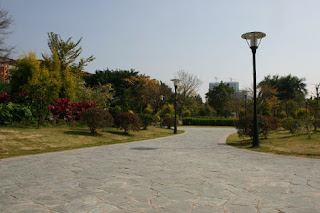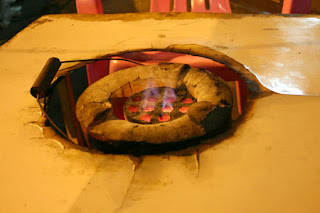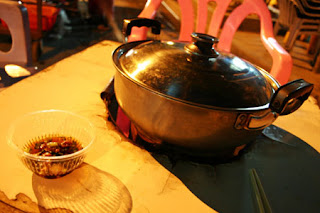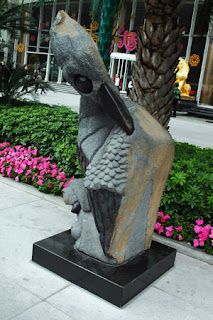 |
| 751 miles approx |
Guangzhou
(pronounced Gwang Jo) or Canton, the capital of Guangdong Province, is the
third biggest city in China after Beijing and Shanghai with a population of
more than 12 million and was founded in 214 BC. In 786AD the city was sacked by
the Persians and in 1711 the British East India Company established a trading
post here. In 1757, the government designated the city as the only port allowed
business transactions with foreign nations. The first Protestant missionary in
China, Robert Morrison, entered Guangzhou in 1807. This started the spread of
Christianity in the country. Cantonese is the prevalent language and differs
greatly from Mandarin, inasmuch that Gaelic differs from English. Many station announcements are in Mandarin, Cantonese and
English. The biggest treat for me was that Guangzhou is so far south that I dug
out my flip flops and sunglasses for a few days!
A small section of the queue for my train before it got busy. This is a typical scene in any railway station.
The unequivocal joy of being horizontal! Each compartment is also provided with a flask of hot water for tea/noodles. I cannot fathom how the Chinese would survive without hot water - its integral to every facet of life.
The sink room and typical Chinese squat toilet - both photographs taken prior to the onslaught of humans
During
this perfectly comfortable sixteen hour train journey in compartment shared with
a young family and a student, I managed
to photograph some of the views that I missed during the last journey.
I
used the subway to get to my hostel which was on the banks of the Pearl river,
the third longest in China. Another great metro system at around 30p to ride
anywhere made this city an easy one to navigate. Dear Mr Transport Secretary, I
paid £11 to get from Cardiff – London, then I paid £7.80 to go four stops on
the tube. In China I can move around a city the size of Belgium for 20p. How
does this make sense? I know that the cost of living in China is much lower
then in the UK, but the proof of the system is visible – in China the subways
are so efficient and well run and cost so little that absolutely everybody
uses them. This means that the system generates almost maximum income.
Everybody in the UK drives because the buses, trains and subways are either
inefficient, expensive or non existent. Even if we charged four times the
amount in China, we would still have a vastly cheaper system than we currently
do which would mean that more people would use it, which would mean more income
which would mean a better service – quid pro quo. I cannot imagine what a
visitor to the UK must think when asked for almost a tenner to travel half a mile on the
only available underground system. I cannot believe anybody wants to visit the
UK at all in this day and age, considering the costs. Besides, Asian subways are just more stylish.
Being
in a sub-tropical city was a treat and it was a welcome change to be in lush
greenery and amongst people who were much more relaxed than the Northerners.
Probably due to the climate, people strolled instead of scurrying, laughed
instead of giggling and dressed in a much less formal style. There was an
altogether more relaxed air about Guanzhou than any other place I’d visited so
far. Its close proximity, around two hours by rail, to Hong Kong (or Kong-ong, as Nanna Dil says) means
that on the plus side English is widely
spoken which gives the old brain matter a rest; on the negative side, it means
that the only breakfasts available in the hostel were ‘English’, ‘American’ or
‘Spanish’. No dumplings!!
Southern China is infinitely more beautiful than Northern China. It is greener, warmer and the buildings are prettier. The people dress less conservatively and spend less time gawking at the long-nose. Much as any other continent/country/city on the planet there is a rivalry between north and south. And (sorry everyone) I can see why. The south in this instance is so much more attractive. Not necessarily more interesting, but certainly more attractive.
Pot of Jasmine tea (6 cups) in a stunning setting = 90p
Tea house
Food
was generally spicier and more exotic then in previous cities. Street food was
very much an evening affair when tables would be placed outside shops and
trestles of produce would be produced. A popular method was taking a basket and
choosing ten different skewers of food (anything from corn on the cob to meats
and leaves) and then sitting at a table which has a hole in the middle. A mini
barbeque is placed in the middle on which a cauldron of broth containing large
slices of ginger, spices and herbs is placed. You then cook your skewers in the
broth. This cost me £1.50.The only moment of disappointment here was when I placed what I thought was a chunky wheel of courgette into my mouth, only to discover that it was a semi-raw circle of eel.
Another
common sight would be stacks of bamboo containers over a flame, steaming rice. You chose
around five ingredients to add to the rice (absolutely no idea what they were
and I have no desire to find out) and then they were steamed and served with a little bowl of crushed chilli. This
cost me £1.
It is said that thanks to this area of China being a vanguard in international relations, Cantonese is the predominant style of westernised cooking found in Chinatowns and takeaways across the globe. Authentic Chinese food is far removed from anything we are used to and Cantonese, modified for western palates, is the minority gastronomic style writ large on a global scale.
Speaking of colonialism - I visited Shamian Island http://en.wikipedia.org/wiki/Shamian_Island which is a beautiful colonial oasis dating from the 18th to the mid 19th centuries – a former business hub of the French and British. Fighting at Guanzhou during the Opium Wars http://en.wikipedia.org/wiki/Opium_Wars was a critical period in Guanzhou’s history.
Speaking of colonialism - I visited Shamian Island http://en.wikipedia.org/wiki/Shamian_Island which is a beautiful colonial oasis dating from the 18th to the mid 19th centuries – a former business hub of the French and British. Fighting at Guanzhou during the Opium Wars http://en.wikipedia.org/wiki/Opium_Wars was a critical period in Guanzhou’s history.
Guangzhou
is home to the Canton Tower and is the tallest tower in the world as well as
the tallest structure in China. It is in the financial district, which is huge
and empty as many financial districts around the world are - maybe it’s a
metaphor…
The Opera House
Canton Tower
The library
The Pearl River runs through the city and is
named for the pearl coloured shells that lie at the bottom.
The hostel was full of douchebags who wore tye-dye clothes
and were rude to the staff, whilst loudly announcing that they ‘were
travellers’ so I spent most of my time out and about. I did manage to fit in
some dumplings at the hostel, this time filled with cabbage, sweetcorn and tuna
and served with soy sauce J
These fruit trees were outside most shops and hotels
I asked for the menu at a streetside fish place, and was shown the 3D options
Fruit carts outnumbered the usual meat carts found elsewhere in the country
One outlet in the tea market. I earned an orange, a cuppa and a nice half hour with the owner for my good custom!
These are not bunnies in cages, not bunnies in cages, not bunnies in cages..., la la la la la
Sacred Heart - the biggest RC Cathedral in China.
This road reminded me of Whitechapel in London - innumerable stalls occupying the roadside selling fruit, nuts and tat
I spent an evening sitting in the sun with a beer catching up with family and friends via the magic of Skype, which was lovely, and prepared for the next and biggest stop – Shanghai. Excited doesn’t even begin to cover it!













































































